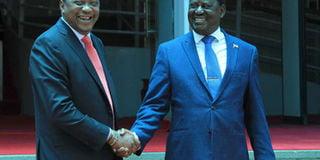Uhuru-Raila truce a window to carry out radical surgery

President Uhuru Kenyatta and Nasa leader Raila Odinga at Harambee House on March 9, 2018. FILE PHOTO | NATION MEDIA GROUP
What you need to know:
From what I gather and what I have observed, the template followed by the mediators was as follows.
First, isolate the hardliners from both sides of the divide and limit engagement to as few people as possible.
Third, don’t involve too many of the major political players; deal mainly with non-partisan types such as family friends.
Hats off to whoever designed the mediation efforts that led to the sudden rapprochement between President Uhuru Kenyatta and the opposition leader, Mr Raila Odinga.
From what I gather and what I have observed, the template followed by the mediators was as follows.
First, isolate the hardliners from both sides of the divide and limit engagement to as few people as possible.
Second, remember that breakthroughs in sensitive mediation efforts tend to happen when proceedings are through informal processes where negotiations are conducted behind the scenes.
Third, don’t involve too many of the major political players; deal mainly with non-partisan types such as family friends, business partners, church leaders and top public officers sworn to secrecy.
PRIVATE SESSIONS
The more private sessions and one-on-one meetings you secure for the protagonists during mediation, the better your chances of success.
They followed the template to the letter and pulled what is clearly the most momentous political event of our time.
Going forward, eyes will focus on the two key men who have been given the responsibility of putting flesh around the deal — Mr Martin Kimani and Mr Paul Mwangi.
Who are they, and how did they come into the picture?
Mr Mwangi is a radical-leaning lawyer who has, over the years, become a confidant of Mr Odinga’s.
He is, perhaps, one of the few remnants of the technocrats who worked in the Prime Minister’s office during the Grand Coalition Government.
He was one of the background advisers to Mr Odinga during the Eurobond investigations and played a key role in the successful election petition against President Kenyatta last year.
Mr Kimani has emerged as a highly regarded diplomat with deep domain knowledge and experience in the conduct of negotiations between political adversaries.
He was one of the main backroom players at the time Kenya was negotiating peace between South Sudan’s President Salva Kiir and his erstwhile deputy Dr Riek Machar in 2015.
Having worked with the high-profile US security think-tank the Atlantic Council, in Washington, and the Institute of Security Studies, in Ethiopia, he also had a short stint at Igad before his appointment as Kenya’s Ambassador to Unep in 2014.
CENTRE OF POWER
Details of the institutional framework which the duo are expected to craft to steer the reform agenda agreed by President Kenyatta and Mr Odinga are still scant.
However, a well-placed source informed me that the objective was not to create another centre of power outside the Constitution.
Still, the deal has just opened a policy window that can allow the country to implement tough and politically difficult reforms that would not otherwise be possible to execute in an environment of brinkmanship.
Policy windows are short and fleeting; if you don’t seize the moment, it can melt away.
I have seen some of the issues which the parties have agreed to implement. Without a doubt, issues such as inclusivity, corruption and devolution are critical.
AGENDA
However, we must ensure that the agenda is not just about the narrow and contemporary obsessions of the political elite.
First, I want to see the agenda for relieving private sector pain. Truth be told, the private sector has been experiencing stunted growth for the past three years.
If you think I am exaggerating, have a look at trends in the turnover of listed companies over the period.
There is also stagnant growth of revenues in the banking sector in the past two years. Indeed, non-performing loans are at levels last seen in the hyper-inflationary years of the early 1990s.
Trends in the consumption of electricity, another proxy for private sector, will also show you that the private sector is not doing too well. Profit warnings of listed firms have been happening at a rate not seen before.
The region’s largest cement maker, ARM Cement, was the latest to issue a profit warning.
And, as we all know, ARM is a proxy for financial health of building construction and real estate — a major locomotive for the economy.
Again, we must use this policy window to stop the reckless and unsustainable borrowing spree which the government has been engaging over the past four years.
Is it not an outrage that we are at a point where debt now costs the government 19 per cent of its revenues?
The truce is also the window to implement the recommendations of the Presidential Task Force on Parastatal Reform.
It should not just be about what the political elite wants.





